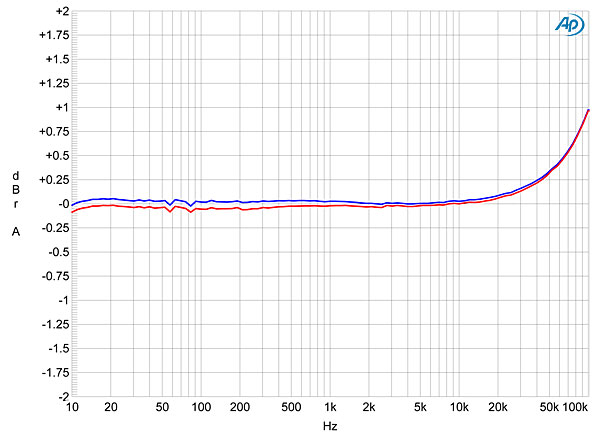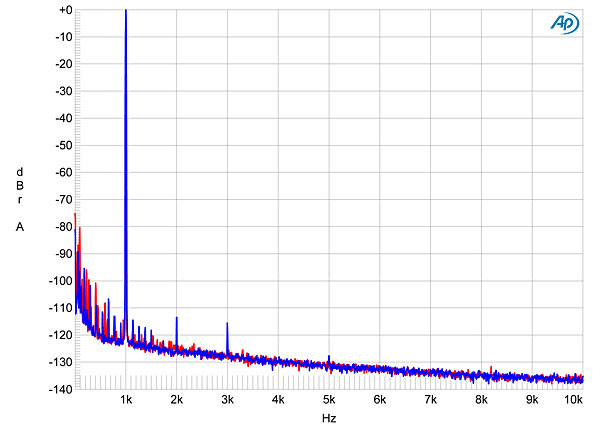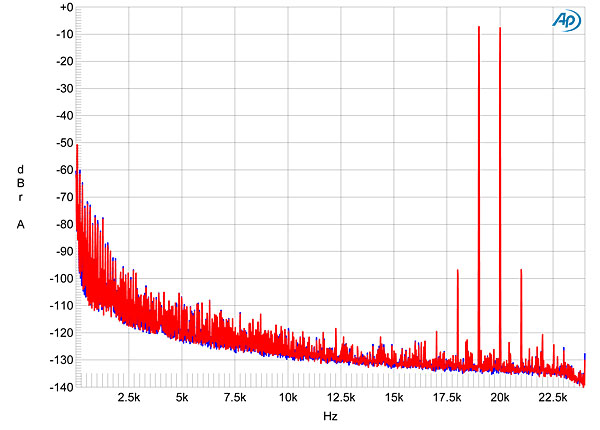| Columns Retired Columns & Blogs |
Precision Transducer Engineering MMMC Phono Preamplifier Measurements
Sidebar 2: Measurements
When Michael Fremer reviewed this $1595 phono preamplifier from Precision Transducer Engineering (PTE) in the October issue (p.31), he liked its sound via its moving-coil input.5 "Drum textures were believable—as were, generally, the percussive attacks," he wrote, adding that "The bottom end was well developed, helping to produce rich lower strings, warm French horns, and an enveloping hall sound. Macrodynamics, while no match for the Einstein [Audio Turntable's Choice]'s, were very good, particularly for $1595." He was less impressed by the sound of the PTE's MM input, however, feeling it sounded "flat, cardboardy, and glary."
PTE's Jim Rush wrote to say that he'd made changes in production to the MMMC's moving-magnet section that had improved its sound, so Michael shipped the review sample (serial no.1006M) back to Rush to be updated. Upon its return, I measured it using Stereophile's loan sample of the Audio Precision SYS2722 system (see the January 2008 "As We See It" and www.ap.com). The voltage gain of the MMMC's MM input was 40.1dB, via the MC input it was 58.5dB—both well suited to the task. Both inputs preserved absolute polarity (ie, were non-inverting). As set by Michael for the review, the MC input impedance was 100 ohms at all frequencies, and the MM input impedance was 39k ohms at the frequency extremes, 45k ohms at 1kHz. The output impedance was a low 100 ohms at high and middle frequencies, rising to 1220 ohms at 20Hz, presumably due to the physically limited size of the output coupling capacitor.
The RIAA equalization was superbly accurate in the audioband, with excellent matching between channels, though an increasingly positive error developed at ultrasonic frequencies, reaching +1dB at 100kHz (fig.1). Channel separation at 1kHz was good, at 80dB R–L and 86dB L–R, and didn't decrease significantly at the frequency extremes. The MM input's unweighted, wideband signal/noise ratio with the input shorted was better in the right channel, which measured 78.5dB, than in the left, at 73.5dB. Both figures are referenced to 1kHz input at 5mV and are improved by A-weighting, to 89.6 and 85.5dB, respectively. The MC input's ratios, again taken with the input shorted but now ref. 1kHz at 500µV, were 70.1dB left and 69.3dB right, unweighted, wideband; and 77.1dB in both channels when A-weighted. The PTE is a quiet preamplifier, the main source of noise being some residual 60 and 180Hz hum, presumably stemming from magnetic interference from the AC transformer.

Fig.1 PTE Phono Preamplifier, response with RIAA correction (left channel blue, right red; 1dB/vertical div.).
Overload margins were excellent, the MM input not reaching 1% THD+noise until the input level at 1kHz was 116.5mV, which is a margin of 27.3dB (ref. 5mV). The 20Hz margin was similarly good, though that at 20kHz dropped to a still adequate 12.7dB. Via the MC input, the margins at 20Hz and 1kHz were almost 31dB, and a still excellent 28dB at 20kHz. It is unusual for a phono preamplifier to offer better overload margins via its MC input than its MM input.
At typical levels, distortion was very low, at about 0.003% via the MM input and 0.04% via the MC input. Fig.2 shows the spectrum of the PTE's output while it reproduced a 1kHz tone via its MC input at 4V into the worst-case load of 600 ohms. The input level was 4.75mV; ie, almost 20dB above the nominal 500µV level. Even so, the only distortion harmonics that poke their heads above the noise floor are the second at –114dB and the third at –116dB. Intermodulation distortion was similarly very low (fig.3). The updated Precision Transducer Engineering MMMC Phono Preamplifier now offers superb measured performance via both its MC and MM inputs.—John Atkinson

Fig.2 PTE MMMC Phono Preamplifier, MC, spectrum of 1kHz sinewave, DC–10kHz, at 4V into 600 ohms (left channel blue, right red; linear frequency scale).

Fig.3 PTE MMMC Phono Preamplifier, MC, spectrum of 19+20kHz sinewaves, DC–24kHz, at 2V into 100k ohms (linear frequency scale).
- Log in or register to post comments




































